Glaucoma Management
Glaucoma is a group of eye diseases that left untreated can cause optic nerve damage. In glaucoma, eye pressure plays a role in damaging the delicate nerve fibers of the optic nerve. When a significant number of nerve fibers are damaged, blind spots develop in the field of vision. Once nerve damage and visual loss occur, it is permanent. Most people don’t notice these blind areas until much of the optic nerve damage has already occurred. If the entire nerve is destroyed, blindness results.

What causes glaucoma?
Though the exact cause is not fully understood, it is known that it involves the mechanical compression and/or blood flow of the optic nerve. It is commonly associated with elevated eye pressure however, one can develop glaucoma with “normal” eye pressure.
What are the types of glaucoma?
OPEN ANGLE GLAUCOMA
The most common form of glaucoma occurs when the eye’s drainage canals become clogged over time. Also, referred to open-angle glaucoma, the liquid in the eye does not flow efficiently through the eye’s sponge-like drainage system. The fluid builds up and increases the pressure in the eye leading to damage of optical nerve fibers. Most people have no symptoms and no early warning signs.
If open-angle glaucoma is not diagnosed and treated, it can cause a gradual loss of vision. This type of glaucoma develops slowly and sometimes without noticeable sight loss for many years. It usually responds well to medication, especially if caught early and treated.
CLOSED ANGLE GLAUCOMA
More rare but serious type of glaucoma is known as closed-angle or narrow-angle glaucoma. In this type of glaucoma, the iris is not as wide and open as it should be. The outer edge of the iris bunches up over the drainage canals, when the pupil enlarges too much or too quickly. This can happen when entering a dark room. A simple test can be used to see if your angle is normal and wide or abnormal and narrow.
Symptoms of angle-closure glaucoma may include headaches, eye pain, nausea, rainbows around lights at night, and very blurred vision.
How is glaucoma treated?
In most cases glaucoma can be treated with special medicines, medicated eye drops. These medicines lower eye pressure either by reducing the amount of fluid created in the eye or by enabling fluid to flow from the eye. It is important that you administer the medicate eye drops properly. If you have any questions about how to administer eye drops, just ask your ECVA technician or your doctor.
Depending on your case and specific type of glaucoma, your doctor may recommend surgery. The goal of the surgery is to improve the flow of fluid out of the eye, resulting in lowering the eye pressure.
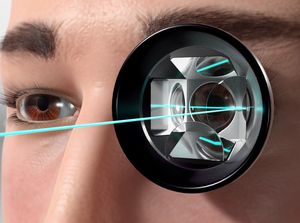
View Video: Argon Laser Trabeculoplasty (ALT) for Glaucoma
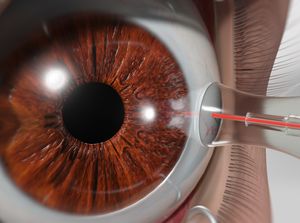
View Video: Laser Cyclophotocoagulation (CPC) for Glaucoma
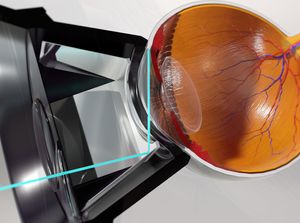
View Video: Selective Laser Trabeculoplasty (SLT)
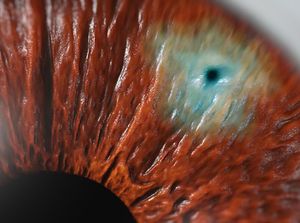
View Video: Laser Peripheral Iridotomy (LPI)
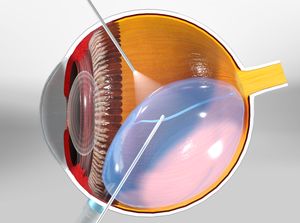
View Video: Vitrectomy
What are the surgical options for treating glaucoma?
LASER TRABECULOPLASTY
A surgery called laser trabeculoplasty is often used to treat open-angle glaucoma. There are two types of trabeculoplasty surgery: argon laser trabeculoplasty (ALT) and selective laser trabeculoplasty (SLT).
Even if laser trabeculoplasty is successful, most patients continue taking glaucoma medications after surgery. For many, this surgery is not a permanent solution. Nearly half of the people who receive this surgery develop increased eye pressure again within five years. Many people who have had a successful laser trabeculoplasty will need more treatment in the future. This treatment may be another laser, more medication or surgery.
SELECTIVE LASER TRABECULOPLASTY – SLT
Selective Laser Trabeculoplasty, or SLT, is a form of laser surgery that is used to lower intraocular pressure in glaucoma.
It is used when eye drop medications are not lowering the eye pressure enough or are causing significant side effects. It can also be used as initial treatment in glaucoma. SLT has been in use for more than 25 years in the United States and around the world.
Who is a candidate for SLT?
Patients who have primary or secondary open-angle glaucoma (the drainage system in the front part of the eye is open) and are in need of lowering of their intraocular pressure (IOP) are eligible for the procedure. Your eye doctor will make the final determination if you are a candidate.
How does it work?
Laser energy is applied to the drainage tissue in the eye. This starts a chemical and biological change in the tissue that results in better drainage of fluid through the drain and out of the eye. This eventually results in lowering of IOP. It may take 1-3 months for the results to appear.
LASER IRIDOTOMY
Laser iridotomy is recommended for treating people with closed-angle glaucoma and those with very narrow drainage angles. A laser creates a small hole about the size of a pinhead through the iris to improve the flow of aqueous fluid to the drainage angle.
TRABECULECTOMY
In trabeculectomy, a small flap is made in the sclera (the outer white coating of your eye). A filtration bleb, or reservoir, is created under the conjunctiva the thin, filmy membrane that covers the white part of your eye. Once created, the bleb looks like a bump or blister on the white part of the eye above the iris, but the upper eyelid usually covers it. The aqueous humor can now drain through the flap made in the sclera and collect in the bleb, where the fluid will be absorbed into blood vessels around the eye.
Eye pressure is effectively controlled in three out of four people who have trabeculectomy. Although regular follow-up visits with your doctor are still necessary, many patients no longer need to use eye drops. If the new drainage channel closes or too much fluid begins to drain from the eye, additional surgery may be needed.
AQUEOUS SHUNT SURGERY
If trabeculectomy cannot be performed, aqueous shunt surgery is usually successful in lowering eye pressure.
An aqueous shunt, or glaucoma drainage device, is a small tube or valve connected to a reservoir (a roundish or oval plate). The plate is placed on the outside of the eye beneath the conjunctiva (the thin membrane that covers the inside of your eyelids and the white part of your eye). The tube is placed into the eye through a tiny incision and allows aqueous humor to flow through the tube to the plate. The fluid is then absorbed into the blood vessels. When healed, the reservoir is not easily seen unless you look downward and lift your eyelid.
A glaucoma valve consists of a small plate with a unique valve system that regulates your eye pressure. Attached to the plate is a tube that drains the fluid out of the eye, thus reducing the eye pressure. The implant is outside the eye, but is covered by the skin of the eye, so it cannot be seen or felt.
There are a variety of implants on the market, but only the Ahmed™ Glaucoma Valve has consistent behavior. The Ahmed™ Glaucoma implant provides effective, long-term control of intraocular press with a high success rate.
What is Glaucoma?
Glaucoma is an eye disease caused by increased pressure in the eye, which can damage the optic nerve and reduce vision, sometimes making objects look blurry or dark. As the disease progresses, the blurriness or darkness expands and can ultimately lead to blindness.
Glaucoma Symptoms and Diagnosis
Glaucoma is an irreversible eye condition; once vision is lost, it cannot be restored. In fact, glaucoma is a leading cause of blindness in the United States. That’s why early diagnosis, treatment, and ongoing management are critical— glaucoma can’t be cured, but it can be treated to help prevent vision loss.
Glaucoma vs ocular hypertension:
Ocular hypertension (or high eye pressure) and glaucoma are two separate conditions that both involve eye pressure, but they have different effects on the eye and vision. High eye pressure means the pressure inside the eye is higher than it should be, but it has not yet damaged the optic nerve or caused any vision loss. It doesn’t have any symptoms—that is, you can’t feel eye pressure—but people with high eye pressure have a higher risk of developing glaucoma.
Glaucoma is a disease involving high eye pressure that damages the optic nerve, which can result in vision loss. Since glaucoma often has no noticeable symptoms in its early stages, regular eye exams, including specific glaucoma tests, are important for early detection and treatment to help prevent vision loss—especially for those with family history of glaucoma who might be at a higher risk.
Managing Glaucoma
The approach to managing glaucoma is changing. Historically, the most common treatment for glaucoma has been prescription eye drops. Although prescription eye drops are still commonly prescribed, in the last decade, minimally invasive procedures have been transforming the way doctors treat high eye pressure and glaucoma.
An Interventional Glaucoma Approach to Treatment
An Interventional Glaucoma approach means choosing a minimally invasive procedure earlier in the treatment journey to help slow the progression of glaucoma and minimize vision loss, while reducing the challenges of daily prescription eye drops.
Discover iDose TR
Looking for an alternative option to prescription eye drops? Ask about iDose TR—a convenient, FDA-approved treatment that helps lower eye pressure in people with open-angle glaucoma or high eye pressure (ocular hypertension). Barely visible to the human eye, iDose TR is a tiny implant specially designed to continuously release proven eye pressure-lowering medication directly inside the eye, when and where it’s needed most.
iDose TR delivers the prescription medication needed to lower eye pressure, without the inconvenience of prescription eye drops or challenges of putting drops in the eye.
iDose TR was proven safe and effective in clinical studies—8 out of 10 people were completely free of prescription eye drops at 12 months with iDose TR.
What Makes iDose TR Unique?
- Helps you take control of your eye pressure without wondering or worrying if you put your medication in correctly and at the right time
- Provides 24/7 continuous release of medication, so you get consistent therapy day and night
- Helps lower eye pressure with minimal side effects
In clinical studies, most people who received iDose TR did not experience any serious side effects. The most common side effects of iDose TR (occurring in 6% or fewer people) were increased eye pressure, inflammation of the iris, dry eye, a loss of part of the usual field of vision, eye pain, eye redness, and reduced vision.
How Does iDose TR Work?
iDose TR is gently placed inside your eye by your eye doctor. The implant steadily delivers prescription-strength medication to help lower eye pressure and reduce the risk of vision loss from glaucoma.
What is the iDose TR Procedure Like?
- Minimally invasive—One iDose TR is carefully placed in each eye through a tiny incision
- Outpatient setting—For most people, the procedure is painless and performed in a facility where you can go home the same day
- Starts working immediately—Medication starts to help lower eye pressure upon administration of iDose TR
Recovery Time and Follow-up
Most people receiving iDose TR go home after the procedure and have a quick return to normal activities Ask your eye doctor about potential side effects, such as eye redness or irritation, and what activities are safe for you to do after your procedure. Individual results may vary.
Insurance Information
iDose TR may be covered by insurance, but the specifics depend on your individual plan and coverage type. Here’s an overview of insurance types and considerations:
- Medicare: a federal government health insurance program for people 65 years of age or older and younger people with disabilities
- Medicaid: joint federal and state program that helps cover medical costs for people with limited income and resources
- Commercial insurance: this private insurance often comes through an employer- sponsored health insurance plan but can also be bought through the Affordable Care Act (ACA) marketplace
Is iDose TR Right for Me?
Think about your current glaucoma treatment plan and ask yourself:
- Am I having any challenges with my treatment, such as difficulty putting in prescription eye drops?
- Do I ever forget to use my prescription eye drops or find my treatment schedule inconvenient?
- Have I experienced any uncomfortable side effects (such as stinging, burning, redness)?
If you answered YES to any of these questions, share your concerns with your eye doctor and discuss if iDose TR could be right for you.
IMPORTANT SAFETY INFORMATION
iDose TR is gently placed directly inside your eye by your eye doctor.
You should not have iDose TR if you have an infection or suspected infection in your eye or the area surrounding your eye, have corneal endothelial cell dystrophy, a condition in which the clear front layer of your eye (cornea) has lost its ability to work normally as this can cause vision problems, have had a corneal transplant or cells transplanted to the inner layer of the cornea (endothelial cell transplant), are allergic to any of its ingredients, and/or have narrow angles (the iris and the cornea are too close together).
The most common side effect of iDose TR was increased eye pressure. Other common side effects were inflammation of the iris, dry eye, a loss of part of the usual field of vision, eye pain, eye redness and reduced clearness of vision.
If you have additional questions, please contact your doctor. For full Prescribing Information click here https://www.idosetr.com/prescribing-information/
APPROVED USES
iDose TR (travoprost intracameral implant) is a prescription medicine and drug delivery system for the eye approved to lower eye pressure in patients with open-angle glaucoma or high eye pressure (ocular hypertension).
You are encouraged to report all side effects to the FDA. Visit FDA Medwatch here www.fda.gov/medwatch or call 1-800-FDA-1088. You may also call Glaukos at 1-888-404-1644.

